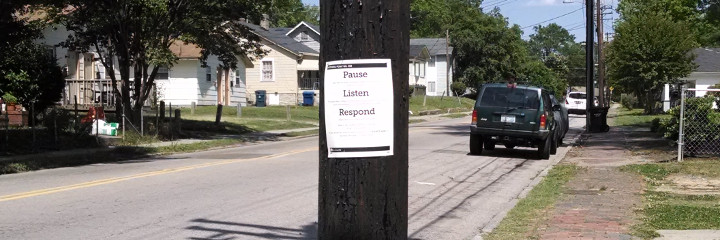This is the second post in a three-part series sharing surprising and illuminating stories that have so far arisen from the Listening Point project. Read part one: The Fallen Sign.
The Lion’s Roar
Twice, now, when I’ve gone to hang or replace a sign on a lamppost along a nearby trail, I have had a rather inquisitive visitor stop by. As I hang up the sign, he rides up on his little red bicycle, which is complete with training wheels and flame decals.
“What are you doing?” he always asks. He couldn’t be more than four years old, so I imagine this is a question of particular importance to him as he goes about his business of trying to make sense of this world.
I explain that I’m hanging up a sign. It’s for people to read when they walk by.
“Oh,” he says. This is a response I’m somewhat familiar with, and I interpret it to mean something along the lines of, “I don’t really understand what you just said, but I’m still paying attention to you.”
The last time the boy and I met, I decided to take a stab at explaining the project in a four-year-old-friendly way. I was curious if he could read the sign himself, so we tried reading the sign together. When it was clear that he wasn’t quite ready to read any of the sign, I read the three large words—Pause, Listen, Respond—to him and explained what they meant.
“Listen really carefully to everything you hear around you right now. What do you hear?” I asked.
“Trees? Bike?” he answered. Nearby, a few different kinds of birds were singing, a jet flew overhead, the transformers of an electrical substation hummed.
I paused for a moment, listening myself, hoping to encourage him to do the same.
“What do you hear farther away?” I asked, thinking of the jet flying overhead.
“A lion!” he said.
I wanted to see if I could steer him back to sounds that he heard in that particular place along the trail, so I asked him where the sound was coming from.
“Africa,” he answered. Of course.
I thought maybe he was interpreting some other sound he heard—that jet, for example—as the lion, so I asked him what kind of sound the lion was making.
He let out a big roar.
The Inner Ear
I didn’t hear a lion roaring that day, but I don’t think it would be entirely incorrect to say that this child did.
The act of intentional listening is very much an interior process. Much like our other perceptual systems, hearing is not a raw, unfiltered line from our ears to our consciousness. Our brains play a very active role in shaping what we hear and how we experience it. I wonder if asking people to actively reflect on their listening experience, we are encouraging more “reverberation” within the mind, so to speak.
In the echo-chamber of the mind, it makes perfect sense that a four-year-old’s rich imaginative experience of the world would mix fluidly with all that he is feeling and sensing. For this child, the lion’s roar was every bit a part of his experience as the sound of that jet overhead was for me. Could he distinguish between the imagined sound of the lion and the “real” sounds he heard? Perhaps, but I didn’t know how to probe that distinction any further without dismantling his experience of that soundscape.
Talking with this young boy about his listening experience really got me thinking about how children’s perception is different from adults’. Is there a way to frame my questioning differently for young children so that they are more likely to attend to the sounds in their physical environment? Or is there more value in maintaining this balance of real and imagined sounds?
Turning to the intended, adult audience of this project, I wonder to what extent this concept of an interior echo-chamber of real and imaginary sounds might apply to adults’ experience as well. In what way does asking an adult to consciously reflect on their listening experience cause them to create sounds from elsewhere in their minds? There are certainly many questions to be asked and many to be answered as I continue with this and future projects.
Turning back to the boy on his bicycle, and packing my bag to head home, I asked, “Do you hear anything else?”
He was quick to respond: “A giraffe.”
Continue reading part three in this series: A Two-Way Street.
